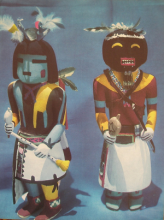Article
Among the Native Pueblo peoples of the American Southwest, the term kachina (often also spelled "katsina”) generally refers to protective deities; either ancestors or guardian spirits. Yet the term can also be applied to masked dancers who personify and become gods or spirits, as well as to the dolls created in the likeness of these dancers and/or the actual gods and spirits. The dolls are traditionally used to teach children to recognize the characteristics and attributes of a Pueblo's spiritual belief system. The pantheon of kachinas is different for each Pueblo, although kachinas are generally understood as supernatural manifestations of elements occurring in the natural world, such as weather phenomena, plants, and animals. In essence, kachinas are perceived as reminders of the animating presence that invests all things in the universe with life, vitality, and purpose.
In the Hopi and Zuni tradition, kachinas are tied to the various clans that make up the tribe, and kachina societies are formed accordingly, each with their own origin stories, and with a variety of ceremonies and traditional spiritual practices.
"Two Hopi kachina dolls, photograph taken December 18, 2008" by Bunky's Pickle.
Manuscripts
A04 Dance Hall of the Dead (04-06) p. 12
A04 Dance Hall of the Dead (04-06) p. 21
A04 Dance Hall of the Dead (04-06) p. 22
A04 Dance Hall of the Dead (04-06) p. 24
A04 Dance Hall of the Dead (04-06) p. 43
A04 Dance Hall of the Dead (04-06) p. 46
A04 Dance Hall of the Dead (04-06) p. 47
A04 Dance Hall of the Dead (04-06) p. 51
A04 Dance Hall of the Dead (04-06) p. 58
A04 Dance Hall of the Dead (04-06) p. 61
A04 Dance Hall of the Dead (04-06) p. 68
A04 Dance Hall of the Dead (04-06) p. 78
A04 Dance Hall of the Dead (04-06) p. 79
A04 Dance Hall of the Dead (04-06) p. 82
A04 Dance Hall of the Dead (04-06) p. 83
A04 Dance Hall of the Dead (04-06) p. 84
A04 Dance Hall of the Dead (04-06) p. 88
A04 Dance Hall of the Dead (04-06) p. 89
A04 Dance Hall of the Dead (04-06) p. 103
A04 Dance Hall of the Dead (04-06) p. 109
A04 Dance Hall of the Dead (04-06) p. 110
A04 Dance Hall of the Dead (04-06) p. 125
A07 The Dark Wind (04-06), p. 9
A07 The Dark Wind (04-06), p. 21
A07 The Dark Wind (04-06), p. 22
A07 The Dark Wind (04-06), p. 60
A07 The Dark Wind (04-06), p. 61
A07 The Dark Wind (04-06), p. 70
A07 The Dark Wind (04-06), p. 134
A07 The Dark Wind (04-06), p. 143
A07 The Dark Wind (04-06), p. 174
A07 The Dark Wind (04-06), p. 228
A07 The Dark Wind (04-06), p. 229
A07 The Dark Wind (04-06), p. 238
A07 The Dark Wind (04-06), p. 247
A07 The Dark Wind (04-06), p. 248
A07 The Dark Wind (04-06), p. 254
References
Loftin, John
2003 Religion and Hopi Life. Bloomington: Indiana University Press.
Stevenson, Matilda Coxe
1898 Zuni Ancestral Gods and Masks. American Anthropologist, 11 (2) (Feb., 1898): 33-40.

